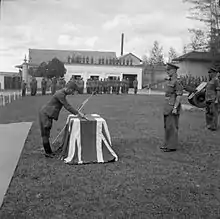Cameron Nicholson
General Sir Cameron Gordon Graham Nicholson, GCB, KBE, DSO & Bar, MC & Bar (30 June 1898 – 7 July 1979) was a British Army officer who served as Adjutant-General to the Forces. He later served as Governor of the Royal Hospital Chelsea.
Sir Cameron Nicholson | |
|---|---|
 Captain Tomeichi Okazaki surrenders his sword to Major General Nicholson in an official ceremony at Johor Bahru, Malaya. | |
| Nickname(s) | "Cam" |
| Born | 30 June 1898 |
| Died | 7 July 1979 (aged 81) |
| Allegiance | United Kingdom |
| Service/ | British Army |
| Years of service | 1915–1956 |
| Rank | General |
| Unit | Royal Artillery |
| Commands held | Middle East Land Forces (1953) Western Command (1951–53) West Africa Command (1948–51) 2nd Division (1944–46) 5th Indian Infantry Division (1944) 21st Indian Infantry Division (1944) 44th Indian Armoured Division (1943–44) Nickforce (1942–43) 42nd Support Group (1941–42) 127th (Manchester) Brigade (1941) |
| Battles/wars | First World War Second World War Mau Mau Uprising |
| Awards | Knight Grand Cross of the Order of the Bath Knight Commander of the Order of the British Empire Distinguished Service Order & Bar Military Cross & Bar Mentioned in Despatches Silver Star (United States) Officer of the Legion of Merit (United States) |
Military career
Cameron Nicholson was commissioned into the Royal Artillery in 1915.[1] He served in the First World War and was awarded Military Cross and Bar in 1918.[1]
Nicholson served with the Royal Horse Artillery in France, India, Iraq, Palestine and Egypt from 1917 to 1927.[1] He served as an instructor at the Royal Military Academy, Woolwich from 1927 to 1930, attended the Staff College, Camberley from 1931 to 1932 and then as an instructor at the Staff College from 1938 to 1939.[1]
He served in the Second World War and was awarded Distinguished Service Order and Bar in 1940.[1] He was appointed Commander of the Support Group of the 42nd Armoured Division in 1941 and then second-in-command of the 6th Armoured Division in 1942. In 1943 he became Brigadier General Staff for the 1st Army.[1] In February 1943 Field Marshal Erwin Rommel launched an assault, known as the Battle of the Kasserine Pass, on units of the British First Army in Tunisia. Brigadier Cameron Nicholson proved an effective combat leader who kept his remaining forces steady under relentless German hammering. The stubborn resistance of the British Nickforce, led by Cameron Nicholson, enabled British Forces to hold the vital road leading into the Kasserine Pass against the heavy pressure of the German 10th Panzer Division, which was under Rommel's direct command.[2]
In 1944 he became General Officer Commanding 44th Indian Armoured Division, a post he held until 1944.[1] He then became successively GOC 21st Indian Infantry Division, GOC 2nd Division, GOC 5th Indian Infantry Division and then GOC 2nd Division again – all of which commands were held while fighting in Burma.[3]
Post-war
In 1946 he became Director of Artillery at the War Office and then in 1948 he was appointed Commander-in-Chief of West Africa Command.[3] Then in 1951 he was made General Officer Commanding-in-Chief for Western Command.[3] Then in 1953 he became Commander in Chief Middle East Land Forces.[3] That same year he also made a visit to East Africa[4] at which time units were engaged in the Mau Mau Uprising.[5] He became Adjutant General later in 1953 and retired from the British Army in 1956.[1]
He was ADC General to the Queen from 1954 to 1956.[1]
He was also Colonel Commandant of the Royal Artillery from 1950 to 1960 and Colonel Commandant of the Royal Horse Artillery from 1956 to 1960.[1]
He was appointed a Companion of the Order of the Bath in 1945, advanced to Knight Commander of the Order of the Bath in 1953 and made Knight Grand Cross of the Order of the Bath in 1954. He was also appointed a Commander of the Order of the British Empire in 1943 and a Knight Commander of the Order of the British Empire in 1950.[1]
Retirement
He was also Master Gunner, St James's Park from 1956 to 1960.[1] He was Governor of the Royal Hospital Chelsea from 1956[6] to 1961.[7]
Bibliography
References
- Who Was Who Volume V11 1971 to 1980 (1981)
- Murray, Brian J. Facing The Fox, America in World War II, (April 2006)
- Generals.dk
- At sea with 3/KAR Regimental Stories, 3 February 2008
- Kenya: Mow Them Down Time, 25 May 1953
- "No. 40917". The London Gazette (Supplement). 2 November 1956. p. 6249.
- "No. 42366". The London Gazette (Supplement). 26 May 1961. p. 3987.
| Military offices | ||
|---|---|---|
| Preceded by John Grover |
GOC 2nd Infantry Division 1944–1946 |
Succeeded by Robert Arkwright |
| Preceded by Noel Irwin |
GOC West Africa Command 1948–1951 |
Succeeded by Sir Lashmer Whistler |
| Preceded by Sir Frank Simpson |
GOC-in-C Western Command 1951–1953 |
Succeeded by Sir Charles Loewen |
| Preceded by Sir Brian Robertson |
C-in-C Middle East Land Forces 1953 |
Succeeded by Sir Charles Keightley |
| Preceded by Sir John Crocker |
Adjutant General 1953–1956 |
Succeeded by Sir Charles Loewen |
| Honorary titles | ||
| Preceded by Viscount Alanbrooke |
Master Gunner, St. James's Park 1956–1960 |
Succeeded by Sir Robert Mansergh |
| Preceded by Sir Bernard Paget |
Governor, Royal Hospital Chelsea 1956–1961 |
Succeeded by Sir Frank Simpson |